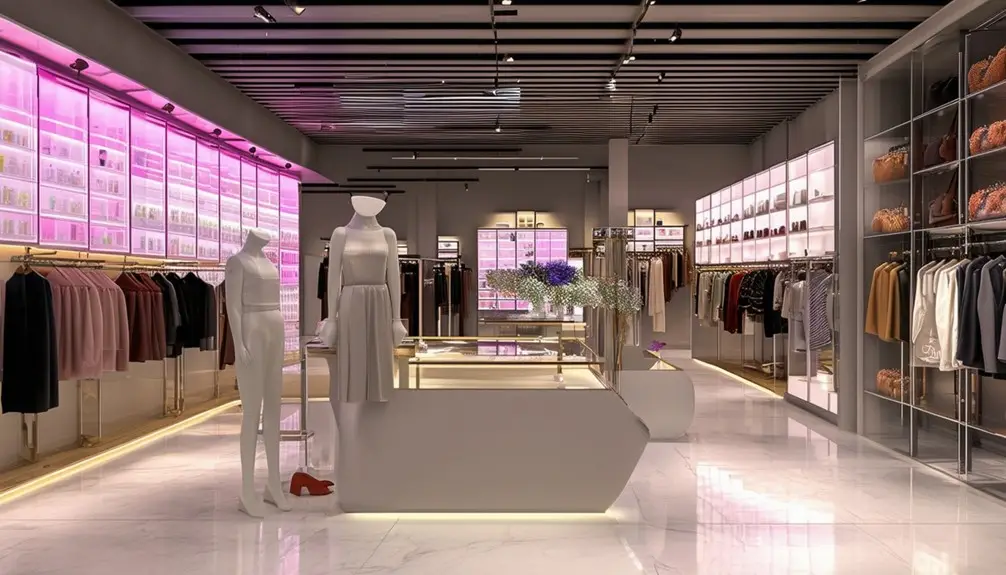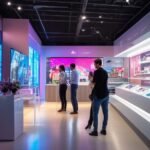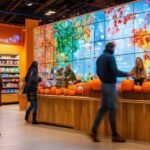Integrating digital menu displays in your clothing store can boost sales and enhance customer engagement. These displays let you showcase high-definition images, prices, and promotions dynamically, creating an immersive shopping experience. Customers can explore products deeply with interactive touchscreens and real-time inventory checks. Highlight best-sellers and limited-time offers to drive urgency and sales. Customizable digital content allows you to feature seasonal collections and new arrivals, ensuring your store remains fresh and inviting. By incorporating user-generated content and social media feeds, you’ll foster greater community engagement. Discover how to maximize these benefits and transform your store’s atmosphere.
Key Takeaways
- Showcase high-definition images, prices, and promotions for a visually engaging shopping experience.
- Highlight best-selling items and limited-time promotions to boost sales.
- Use interactive touchscreens for easy browsing of sizes, colors, and availability.
- Provide personalized product recommendations and styling tips to enhance customer engagement.
- Leverage cloud-based content management for real-time updates and optimal messaging.
Benefits of Digital Menu Displays

Frequently, digital menu displays in clothing stores provide a visually engaging way to showcase product images, prices, and promotions, transforming the shopping experience for customers. By integrating dynamic content, these displays become more than just screens—they create an immersive shopping experience that captures attention. The interactive nature of digital menus allows customers to explore products deeply, viewing high-definition images and detailed pricing information at their own pace.
One of the significant benefits is the ability to boost sales. Highlighting best-selling items or limited-time promotions directly on the display can drive impulse purchases and increase overall revenue. Real-time updates enable you to swiftly change pricing, update product information, or introduce new promotions, ensuring that customers always have the most current information.
Additionally, these displays can reduce perceived wait times at checkout. While waiting, customers can engage with visually appealing content, making the wait feel shorter and less tedious. The ease of updating digital menus means you can quickly adapt to inventory changes or new market trends without hassle. Overall, by using digital menu displays, you create a modern, efficient, and engaging shopping environment that enhances customer satisfaction and loyalty.
Customizing Your Digital Content
By customizing your digital content, you can create a personalized shopping experience that not only showcases your latest collections in high definition but also strategically highlights seasonal promotions and new arrivals. High-definition images are essential for clothing stores, as they allow customers to see every detail of your garments, making your offerings more attractive.
Digital menu displays can be tailored to feature dynamic content, including videos, animations, and customer testimonials, effectively capturing shoppers’ attention. Interactive touchscreens let customers easily browse through different clothing categories, making their shopping journey more engaging and user-friendly.
Incorporating branding elements such as your logo, color scheme, and fonts helps maintain consistency and reinforces your store’s identity. This customization ensures that your digital signage is not just informative but also a powerful branding tool.
Enhancing In-Store Experience
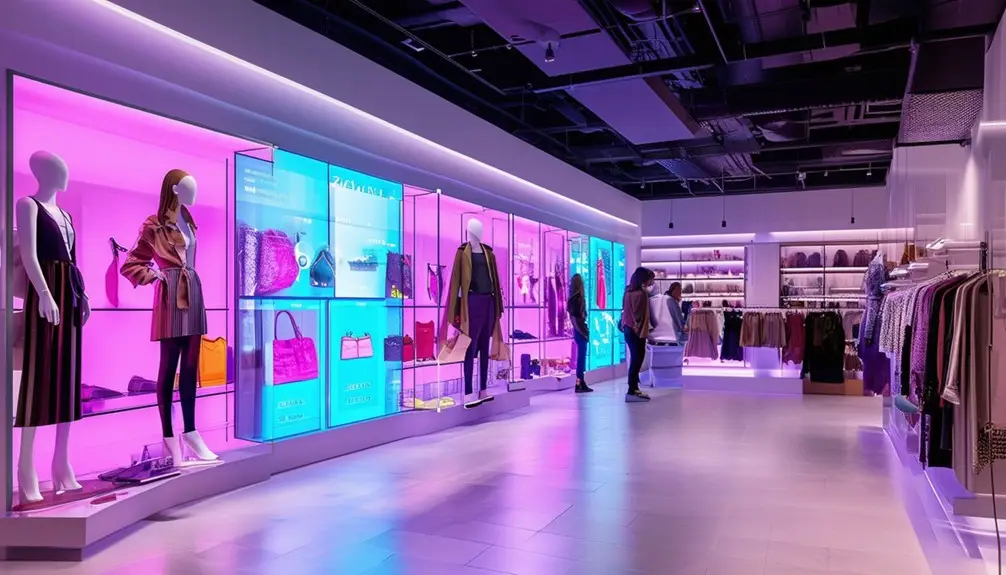
You can transform your store’s atmosphere with dynamic visual merchandising that captures attention and stimulates interest. Interactive digital displays let customers effortlessly explore sizes, colors, and availability, enhancing their shopping experience. By integrating these technologies, you create an engaging environment that keeps shoppers informed and entertained, ultimately boosting satisfaction and sales.
Dynamic Visual Merchandising
Incorporating digital menu displays into clothing stores greatly enhances the in-store experience by offering vibrant and ever-changing visual merchandising that captivates customers. These dynamic visual merchandising tools allow you to showcase the latest trends, promotions, and product information in a visually engaging way. By constantly updating the content, you can keep your store looking fresh and inviting, encouraging customers to explore and engage more deeply with your offerings.
Here’s how digital menu displays can transform your clothing store:
- Dynamic Content Updates: Easily promote new arrivals and highlight seasonal collections with just a few clicks, ensuring that your visual merchandising is always current and relevant.
- Interactive Features: Engage customers with interactive features that provide styling tips, suggest outfit combinations, and offer detailed product information, enhancing their overall in-store experience.
- Increased Customer Engagement: By creating a modern shopping environment, digital menu displays not only attract attention but also drive sales by encouraging customers to spend more time in the store and explore various products.
Interactive Shopping Experience
Imagine walking into a clothing store where you can instantly browse through a digital menu display to check sizes, colors, and availability in real-time, creating a seamless and greatly personalized shopping experience. These interactive digital menu displays transform the in-store shopping experience by providing detailed product information, pricing, and promotions at your fingertips.
| Feature | Benefit |
|---|---|
| Real-time Inventory Check | Know what’s in stock instantly |
| Detailed Product Info | Access to colors, sizes, prices |
| Virtual Try-Ons | Visualize outfits without hassle |
| Outfit Pairing Suggestions | Discover complementary items |
| Personalized Recommendations | Tailored options just for you |
Engage with interactive features like virtual try-ons, where you can see how an outfit looks without stepping into a fitting room. Outfit pairing suggestions help you find the perfect match for your new jeans, enhancing your overall in-store shopping experience. These displays streamline the shopping process, reducing wait times, and greatly increasing customer satisfaction.
Boosting Customer Engagement
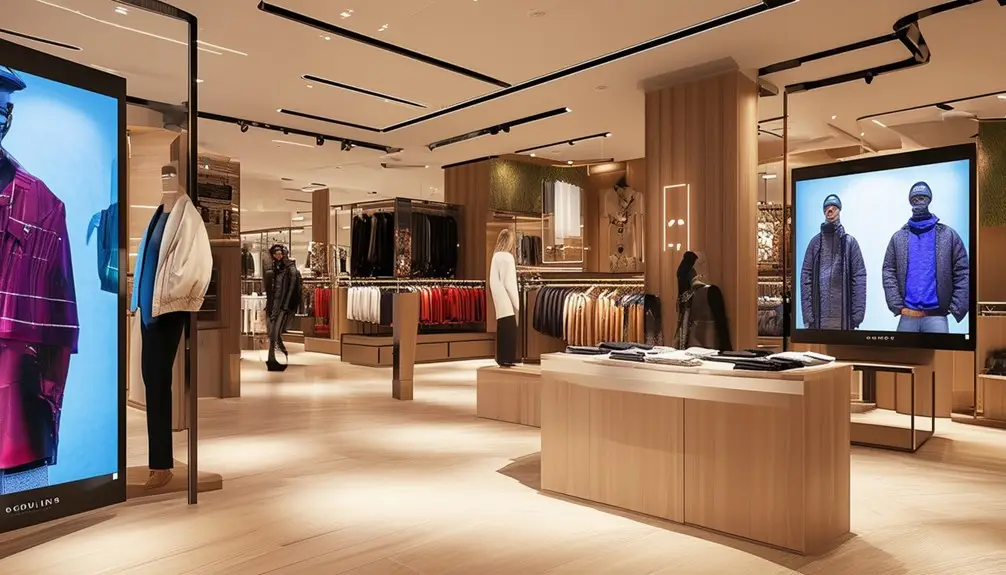
Utilizing vibrant digital menu displays in clothing stores greatly enhances customer engagement by showcasing product details and promotions in an eye-catching manner. By leveraging interactive features, you can allow customers to explore clothing options and gather information seamlessly. These displays can be updated dynamically, ensuring that customers are always informed about the latest trends and offers.
To further enrich the shopping experience, consider integrating the following elements:
- Product Recommendations and Styling Tips: Display tailored suggestions based on customer preferences and current fashion trends. This not only aids in decision-making but also elevates the overall shopping experience.
- Social Media Integration: Show live feeds from your social media channels. This keeps customers connected with your brand’s community and highlights trending styles and promotions.
- User-Generated Content: Featuring photos and reviews from real customers builds trust and encourages others to share their experiences, fostering a sense of community.
These strategies help transform digital menu displays into powerful tools for boosting customer engagement. Not only do they provide valuable information, but they also create an interactive and personalized shopping environment that drives sales and brand loyalty.
Deployment and Management Tips
To effectively deploy and manage digital menu displays in clothing stores, start by leveraging cloud-based content management systems that enable seamless real-time updates and streamlined content scheduling. By using these platforms, you can easily control what content is displayed and adapt it instantly based on customer behaviors or promotional needs.
Incorporate scheduling features to guarantee your messaging is optimized for different times of the day, allowing you to display morning promotions for early shoppers and evening deals for after-work customers. Integrating data analytics is vital; it helps track customer engagement and tailor your content to better suit their preferences, thereby enhancing their shopping experience.
High-quality visuals and legible text are essential. Ensure your displays showcase products and pricing clearly and attractively. Consider adding interactive features like touchscreens or QR code scanning to boost customer engagement. These interactive elements provide additional product information and make the shopping experience more dynamic and informative.
For effective deployment, prioritize high-traffic areas in your store where customers are likely to notice and interact with the displays. Ongoing management strategies should focus on regularly updating content and monitoring performance to guarantee your digital menu displays remain relevant and engaging.
Analyzing Signage Performance

Analyzing the performance of your digital menu displays involves tracking key metrics like customer engagement, dwell time, and conversion rates to gain valuable insights into their effectiveness. By gathering data insights, you can optimize content, promotions, and product placements on your digital displays, ensuring they resonate well with your audience.
To effectively analyze signage performance in your clothing store, follow these steps:
- Track Key Metrics: Monitor customer engagement, dwell time, and conversion rates. These metrics will help you understand how customers interact with your digital menu displays and the overall impact on sales.
- Implement A/B Testing: Compare different visuals, messages, and promotions to determine which combinations drive the most engagement and sales. Use this information to refine your digital menu displays.
- Leverage Real-Time Analytics: Use real-time data to make swift, data-driven decisions. This allows you to adjust promotions and product placements on the fly to maximize their effectiveness.
Case Studies in Retail

In examining various case studies, you’ll discover how digital menu displays have revolutionized retail environments, demonstrating substantial improvements in sales, customer engagement, and overall store efficiency. For instance, a clothing store in New York saw a remarkable 20% sales increase after implementing digital menu displays. This uptick can be attributed to the engaging presentation of product information, which research shows makes 78% of customers more likely to make a purchase.
Additionally, a boutique in Paris reported a 30% reduction in customer wait times by showcasing clothing options on digital menu displays. This streamlined approach not only enhances customer satisfaction but also increases the average transaction value by 40%, as indicated by further research.
An upscale fashion retailer in London experienced a 25% foot traffic boost by using digital menu displays to highlight new arrivals and promotions. This strategy effectively captures the attention of passersby, drawing them into the store and converting interest into sales.
These case studies illustrate the multifaceted benefits of digital menu displays in clothing stores, ranging from sales increases and reduced customer wait times to higher transaction values and boosted foot traffic. The evidence clearly supports their transformative impact on the retail sector.
Future Trends in Digital Signage
You’re about to witness a transformation in digital signage through interactive shopping experiences and AI-driven content personalization. Imagine customers interacting with displays that offer virtual try-ons and personalized recommendations based on their preferences. These innovations not only enhance engagement but also make shopping more enjoyable and efficient.
Interactive Shopping Experiences
Frequently, the future of digital signage in clothing stores hinges on interactive shopping experiences that captivate customers through advanced technologies like touchscreens and virtual try-on features. Imagine walking into a store and being able to virtually try on clothes through augmented reality (AR). This immersive shopping experience not only saves you time but also offers personalized product suggestions based on your preferences.
Three key trends are transforming how you shop:
- Touchscreens: These interactive displays let you mix and match outfits, browse collections, and even customize your look.
- Virtual Try-On Technology: By using AR, you can visualize how clothes will look on you without physically trying them on.
- Artificial Intelligence (AI): AI-driven interactive digital menu displays analyze your choices and recommend items you’ll love, enhancing customer engagement.
These innovations not only make shopping more enjoyable but also gather valuable customer data. Stores use this data to create targeted marketing strategies that cater specifically to your tastes, driving sales and fostering loyalty. Ultimately, integrating interactive technology creates memorable shopping experiences, making you more likely to return.
AI-Driven Content Personalization
AI-powered content personalization is transforming digital signage in clothing stores by analyzing customer data and delivering uniquely tailored content that enhances your shopping experience. Imagine walking into a store where the digital menu displays change dynamically to reflect your preferences. This isn’t science fiction—it’s the future of retail.
By leveraging advanced algorithms, clothing stores can utilize targeted messaging based on demographics, purchase history, and individual preferences. Through detailed customer data analysis, these digital menu displays can present you with personalized promotions that are too good to ignore. The technology goes even further by implementing dynamic pricing strategies, adjusting prices in real-time to match your shopping behavior and market trends.
Real-time optimization guarantees that the content you see is always relevant, making your shopping experience more interactive and engaging. Whether it’s suggesting a new jacket that matches your style or offering a discount on a brand you’ve purchased before, AI-powered content personalization aims to enhance customer engagement and drive sales.
In essence, AI-driven content personalization transforms digital menu displays into smart, responsive tools that cater to your unique tastes, making your shopping experience more enjoyable and efficient.
Conclusion
In the whirlwind of retail innovation, digital menu displays are your secret weapon. They don’t just enhance customer experience; they transform it, turning browsers into buyers with the flick of a digital wrist. By customizing content and analyzing performance, you’ll boost engagement and stay ahead of trends. So, immerse yourself, embrace the future, and watch your store’s potential unfold like a well-tailored suit. The future of retail is digital, and it’s within your grasp.
Frequently Asked Questions
How Much Does a Digital Menu Cost?
A digital menu can cost anywhere from $500 to $5,000. Variables include display technology, resolution, and whether it’s standalone or networked. Additionally, maintenance, software updates, and advanced features like touchscreens can raise the price.
What Is a Digital Display Menu?
Digital display menus boost sales by 20%. They’re dynamic electronic boards that showcase product info, pricing, and promotions. You can easily update them in real-time, enhancing customer engagement with visually appealing and interactive content.
What Size Are Digital Menu Boards?
Digital menu boards typically range from 32 to 86 inches. You should choose the size based on your layout and viewing distance. Larger sizes suit high-traffic areas, while smaller ones work best in limited spaces.
How to Turn a TV Into a Menu Board?
Where there’s a will, there’s a way. Connect a media player to your TV, install digital signage software, and customize your display with images, prices, and descriptions. Schedule content and mount the TV where it’ll attract attention.

